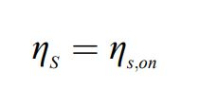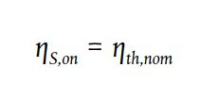Comparing the regulation text and formulas
The following tables show the differences between the formulas and descriptive texts in the old and new regulations.
The seasonal space heating efficiency ηs is calculated differently for
- Gaseous and liquid fuel domestic LSH
- Electric (domestic) LSH
- (Gaseous or liquid fuel) commercial LSH
The calculation uses LSH-type depending correction factors F(1) to F(5). They are for both regulations defined as follows:
- F(1) accounts for a negative contribution to ηS for commercial LSH due to adjusted contributions for options for the heat output
- For regulation 2015/1188 F(1) also accounts for a positive contribution to ηS of electric storage LSH due to adjusted contributions for options for heat storage and output
- F(2) accounts for a positive contribution to ηS due to adjusted contributions of controls of indoor heating comfort, the values of which are mutually exclusive, cannot be added to each other
- F(3) accounts for a positive contribution to ηS due to adjusted contributions of controls for indoor heating comfort the values of which can be added to each other
- F(4) accounts for a negative contribution to ηS by auxiliary electricity consumption
- F(5) accounts for a negative contribution to ηS by energy consumption of a permanent pilot flame
Moreover, the following two parameters are used for calculations:
- ηs,on is the seasonal space heating energy efficiency in active mode, expressed in %;
- CC is the conversion coefficient for electricity (2,5 for (EU) 2015/1188 and 1,9 for (EU) 2024/1103).
See the table below.
| Old regulation (EU) 2015/1188 | New regulation (EU) 2024/1103 | ||||||||||||||||||||||||||||||||||||||||||||||
Calculation of the seasonal space heating energy efficiency ηs | |||||||||||||||||||||||||||||||||||||||||||||||
Annex III, 5, a. For domestic LSH: ηS = ηS,on - 10% + F(1) + F(2) + F(3) - F(4) - F(5) | Annex III, 4, (1.)
(b) for electric LSH: | ||||||||||||||||||||||||||||||||||||||||||||||
For commercial LSH ηS = ηS,on – F(1) – F(4) – F(5) | |||||||||||||||||||||||||||||||||||||||||||||||
Calculation of ηs,on | |||||||||||||||||||||||||||||||||||||||||||||||
Annex III, 5, b. The seasonal space heating energy efficiency in active mode is calculated as: For gaseous and liquid fuel domestic LSH: Where:
For electric LSH: Where:
| Annex III, 4 (2) The seasonal space heating energy efficiency in active mode (ηS,on) is calculated as: (a) for domestic LSH: ηS,on = ηth,nom . (0, 75 + F(2) + F(3)).F(4).F(5) where:
| ||||||||||||||||||||||||||||||||||||||||||||||
Calculation of correction factors F(1) to F(5) | |||||||||||||||||||||||||||||||||||||||||||||||
dfasdfsaAnnex III, 5, (c) Correction factor F(1) for electric storage LSH
In case the heat output of the electric storage local space heater is assisted by a fan, an additional 1,5 % shall be added to F(1). | In the new regulation, there is no correction factor F(1) for electric storage LSH.
For commercial: xxx
| ||||||||||||||||||||||||||||||||||||||||||||||
Please view table 7 in Annex III, 5 (d) Correction factor F(2)
| Correction factor F(2):
See also table 10 in Annex III, 4, (4) | ||||||||||||||||||||||||||||||||||||||||||||||
Please view table 8 in Annex III, 5 (e) Correction factor F(3)
| Please view table 11 in Annex III, 4, (5) Correction factor F(3)
| ||||||||||||||||||||||||||||||||||||||||||||||
Annex III, 5 (f) Correction factor F(4)
For electric LSH: Where:
For domestic LSH using gaseous or liquid fuels: Where:
For commercial LSH | Annex III, 4, (6) Correction factor F(4) (a) for gaseous and liquid fuel LSH except commercial LSH:
(b) for commercial LSH:
(c) for electric LSH F(4) = 1
| ||||||||||||||||||||||||||||||||||||||||||||||
Requirements on low power modes | |||||||||||||||||||||||||||||||||||||||||||||||
| Requirements concerning low power modes are not included in the old regulation | Annex III, 5 All low power modes oldly implemented in LSH generate additional energy consumption. Therefore, specific ecodesign requirements for low power modes, including idle mode or networked standby mode, are set out in the new regulation both for LSH and separate controls
| ||||||||||||||||||||||||||||||||||||||||||||||
Requirements on control accuracy (CA) and control to setpoint deviation (CSD) | |||||||||||||||||||||||||||||||||||||||||||||||
| Requirements concerning control accuracy and control to setpoint deviation are not included in the old regulation | ANNEX III, 6. Where:
| ||||||||||||||||||||||||||||||||||||||||||||||







